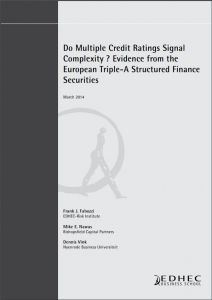

Do Multiple Credit Ratings Signal Complexity? Evidence from the European Triple-A Structured Finance Securities
In much of the current research on market practices with respect to the use of credit ratings, the rating shopping hypothesis and the information production hypothesis feature prominently. Both of these hypotheses predict an inverse relationship between the number of ratings and a security’s funding cost; that is, more ratings will reduce funding costs and, conversely, fewer ratings will increase funding costs. This study finds precisely the opposite to have been the case for the mainstay of the structured finance securities market in Europe prior to 2007, namely the triple-A tranches of European residential mortgage-backed securities.
Author(s):
Summary:
In much of the current research on market practices with respect to the use of credit ratings, the rating shopping hypothesis and the information production hypothesis feature prominently. Both of these hypotheses predict an inverse relationship between the number of ratings and a security’s funding cost; that is, more ratings will reduce funding costs and, conversely, fewer ratings will increase funding costs. This study finds precisely the opposite to have been the case for the mainstay of the structured finance securities market in Europe prior to 2007, namely the triple-A tranches of European residential mortgage-backed securities.
Register to download PDF
Register/Log in| Type : | Working paper |
|---|---|
| Date : | 03/03/2014 |
| Keywords : |
Credit Ratings |

